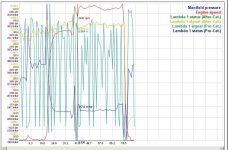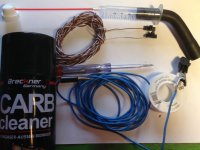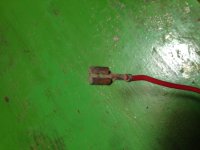One last detail that I forgot to mention about cleaning the cat is not to forget to clean the precat O2 sensor too, with a cloth and vinegar.
The injectors cleaning process: first of all, I'll put the link of an youtube video with the method, the explaining in this video is in Romanian, but the images speak louder than the voice:
youtu.be/RgfcghsAjG8
So what you do is to spray carb cleaner through a sealed system into injectors and connect the injector to DC to open it, so the cleaning to be properly done. The system in this method is a syringe of which you take the piston out and put the injector instead and on the tip of the syringe you fix the carb spray's pipe. When all is in place, push spray in, it will be under pressure, then connect the injector to open and let the spray go through and do the cleaning.
Basically that is the method I used and I made some little adjustments to be able to use it. I have a photo with these.
First of all, I couldn't fit the injector in the syringe and I used a piece of hose that I found around, something from an old car. Luckily that hose was a perfect fit and it has one end wider than the other, that is where I put the injector and the other end fits perfectly into the syringe. I don't have an injector at hand now as I've placed them back on the car and I took the picture now. One thing to be careful here, when you do the cleaning, hold the injector and hose in the hand, as by spraying cleaner, pressure builds up and when I've tested if the pressure stays in, I pressed a bit too much in and the injector was projected out of the hose with a "boom" sound. It hit the table that was close underneath and luckily it didn't get damaged.
At the other end, the tip of syringe, I used some teflon tape on the pipe because it was thinner than the inside of the syringe's tip. Placed that tip with teflon in and then, what you don't see in the picture, I taped together the pipe and the tip with a little bit of power tape so that pressure won't open them apart.
So this is the sealed system that you use, to push spray inside the injector.
Now for that part I think that another similar system could be made and maybe is a little bit easier to use. That is to place the same syringe on the injectors' rail, instead of the fuel line and let all the injectors connected. Then one at the time, conect the DC to the injector and that is it.
For the wiring (and for picture's purpose I found this old injector's plug that broke off) I used the wires with those little black plastic pieces on tip. I don't know were that came from, it was a cross-kind thing that I cut in half and it fit very good on the injector's connectors. I think you can fit some little plugs on them as well (plugs being connected to wires) or as in the picture, you can use two cables from checking lamps and put the little pliers on the connecter. If you use little pliers, the best is to put some tape so that pliers won't touch when you move injector around.
So that's kind of it. I didn't take the battery down, just performed the cleaning on the car. I've connected a wire to - negative voltege on batery and the + one just touched the battery's + when needed. Took a cloth in hand, at the tip of the injector, hold the injector and the hose steady, sprayed carb cleaner and connected the positive contact wire. At first the jet coming out of the injector was really poor and in a few seconds it got really good. Disconnected the + wire, sprayed some more cleaner and connected again until it was good. Did that to all injectors, then placed them back on. The result is good, I like it, the car runs smoother now and at this time it shows an improvement in fuel consumption. I know is early for that as I took only a little trip but I compare it with how it was before. And before, for the early kms done (up to about 50) the computer always showed me a higher fuel consumption than later on, so it was alway way above 10l/100km, even 15. Now for 13.3 km done it is 9l/100km.
One little tip: to be able to get the injectors out with ease, after you get all the screws out, grease the tip of injectors. I used engine oil, there is place to put a little bit of oil towards the injectors' o-rings. After I got the rail with all the injectors out, I did the same to get them out of the rail, used oil. And I did the same when placing them back on, I've oild the o-ring and they've just popped in very easily. If you don't grease them it's really hard to put them in (and also to get them out) and you can even tear the o-ring.
The time to do this cleaning was about 1 and a half hour but that includes the time to have the sealed system done (and I adapted the video presented method with adding the hose).




